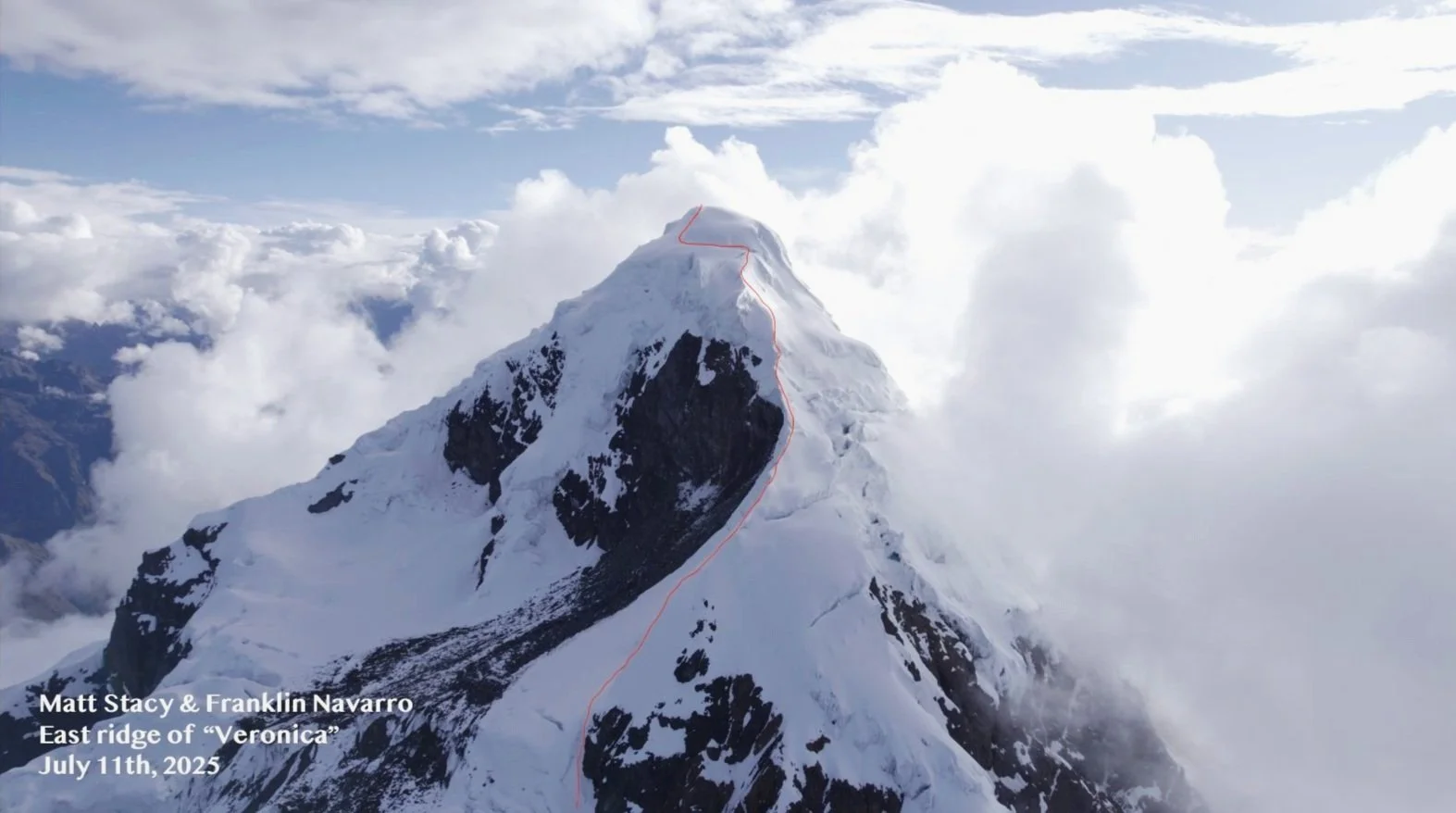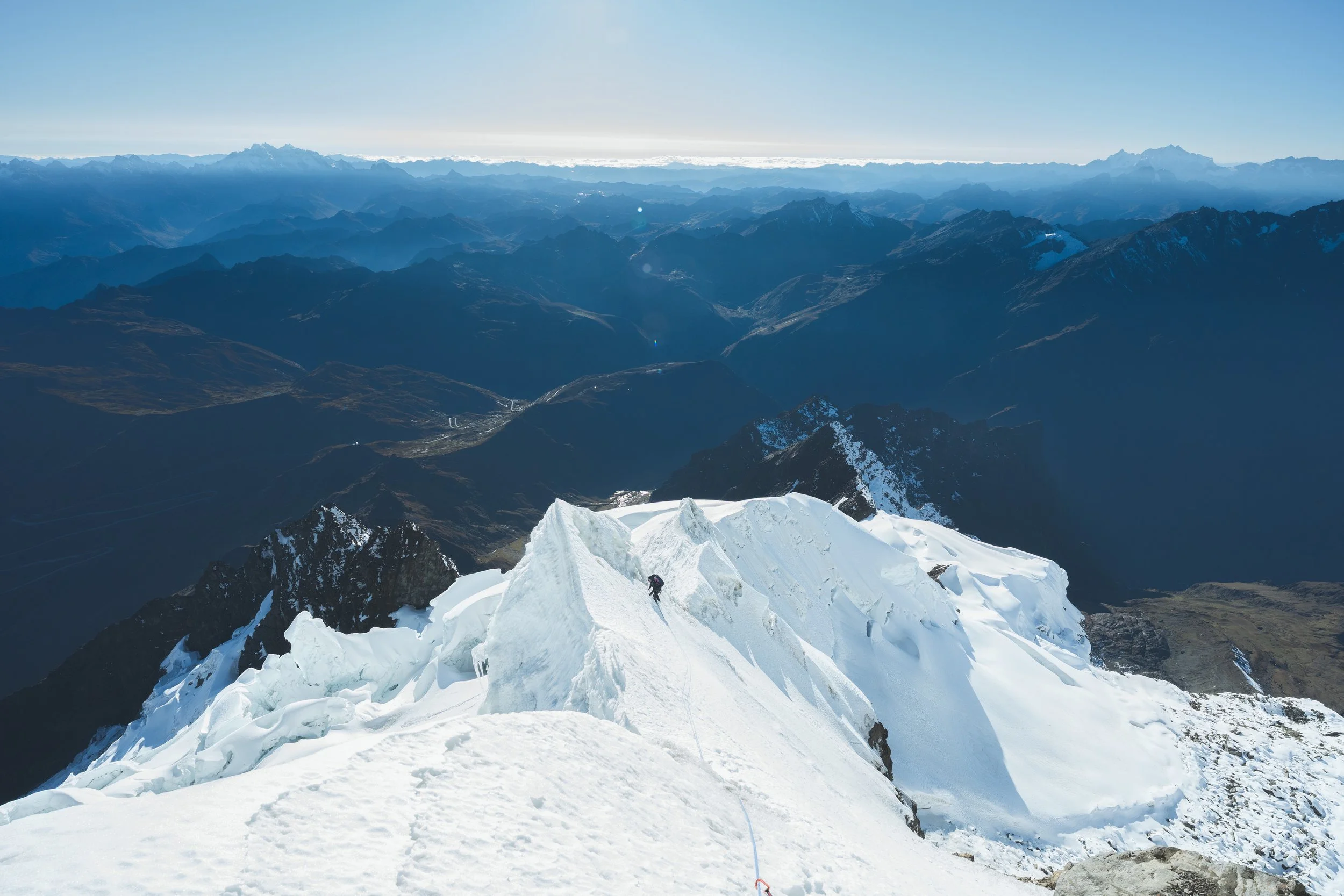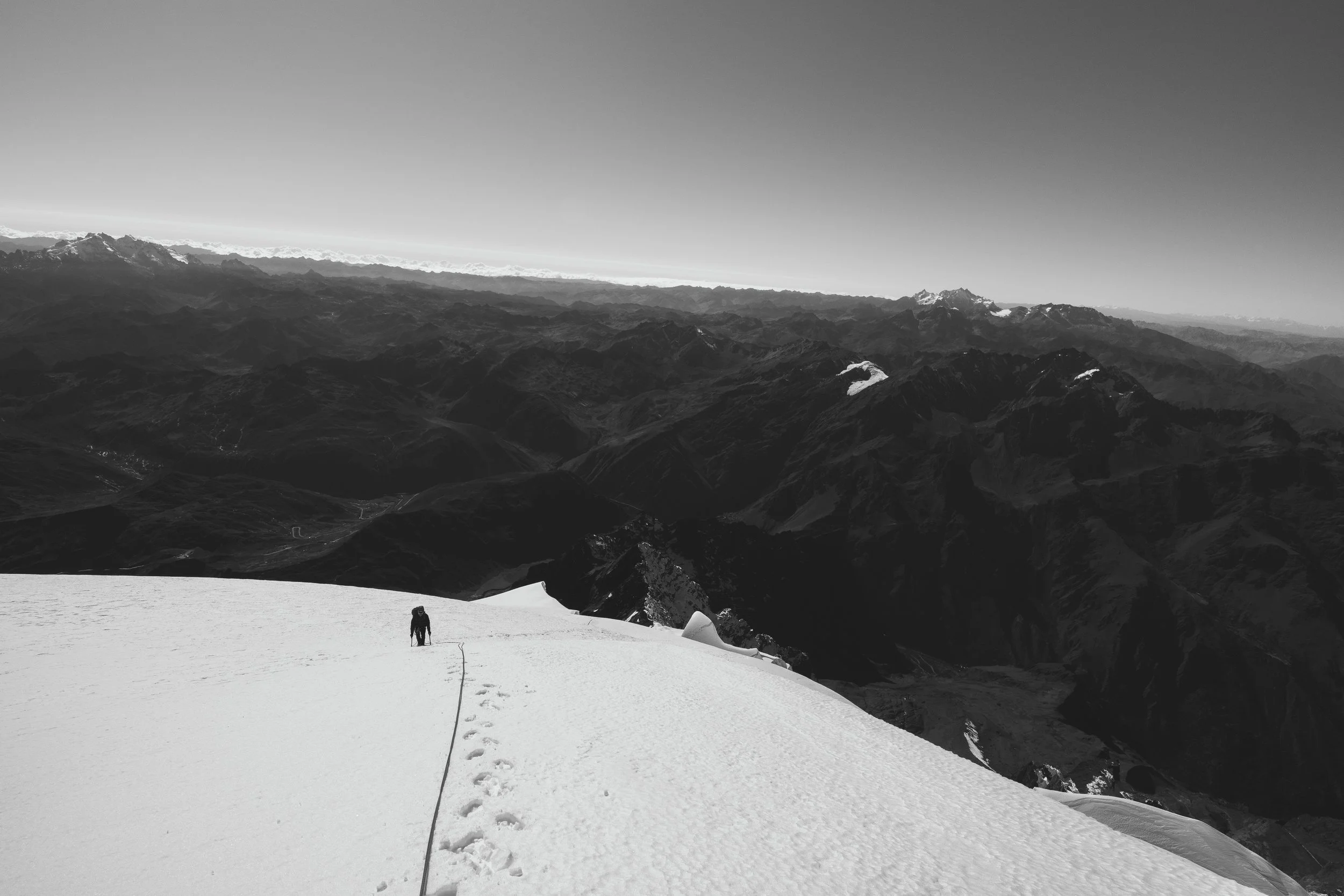Climbing Nevado Veronica by the East Ridge 5911m
Nevado Veronica, or Waqaywillka in Quechua, meaning "Sacred Tears," rises 5,911 meters above sea level, the tallest peak in the entire Urubamba mountain range. Its unmistakable pyramidal shape can be seen on the horizon while going from Cusco to Urubamba, climbing peaks as far as the Vilcanota mountain range 70 km away, or even, most famously, from the Inti Puku archeological site above Ollantaytambo, where thousands of tourists flock every year to photograph the juxtaposition of ancient Inca ruins and this snow-covered Andean god. I'd tried climbing Veronica a couple of times before this, and each time I was turned away by a storm or sickness, and it wasn't until this third attempt that I was granted passage to its highest point.
On July 9th, 2025, my friend Franklin and I began our journey to the NE ridge route of Veronica, starting at Abra Malaga, the mountain pass that connects the Sacred Valley to the lush high jungle city of Quillabamba. It was our second attempt at the mountain this year. Our previous attempt, back in April, ended with us retreating, nervous for our lives, when, at our high camp at 5300 meters, electrical storms from the Amazon Basin threatened us in every direction. Luckily, the storms that subsequently engulfed us only brought heavy snowfall and moderate winds. This time, the forecast promised a prolonged weather window, and we were determined not to return to the mountain again without reaching the summit. I was fresh off my solo climb of Sirijuani and felt the strongest I ever had since living in Peru.
On day one, Franklin and I powered through 750 meters of elevation gain, climbing to 4,900 meters in just three and a half hours, where we established our base camp. It was a significant improvement from our previous 5-hour effort and a favorable indication of our strong physical condition. The month of July coincides with the peak of the Andean dry season, marked by cloudless skies and a noticeable drop in temperature. Our primary concern was the 40-meter 5.7 rock climbing section, which we needed to ascend in order to go from base camp to high camp. While some may consider the rating easy, climbing in rigid mountaineering boots on rock coated in verglas or cascading with water from melting snow from above is a challenging effort. So on day 2, we ascended the east-facing rock section around 9am, mindful of the frigid night and the possibility of freezing. We broke camp later than usual, allowing the sun to melt the ice just enough to keep us dry. After ascending the rock section, we arrived at the glacier, where everything proceeded as usual. Franklin led the final 200 m to high camp by setting the trail through mushy snow up to 5300 m.
When I first attempted Veronica in 2024, our group set up base camp at 4750 meters. The following day, we hiked for a single hour to reach an advanced base camp at 4,900 meters—the same spot where Franklin and I established our camp on day one during this ascent. From there, the plan was to push 1,000 meters to the summit. During the attempt, I remember passing through several large glacial platforms around 5300 m. And although I didn’t reach the summit on that attempt, I remember thinking that climbing and descending 1,000 meters in a single day was unnecessarily exhausting. I thought, "Why not spend the second day establishing a higher camp on the glacier to make the summit push only a mere 600 m?" And so that's what we did, and it worked out perfectly. We set up camp on a glacial platform by noon on the second day of our climb, with excess time to rest and do camp chores.
At 1am on day three, we reluctantly said goodbye to the comfort of our cozy sleeping bags. After a warm drink and light meal, we started our bid for the summit. I can't say for certain that we were the first team to climb the mountain by this route this season, but while I was breaking through thigh-deep snow on one of the early south-facing slopes, I wished we weren't. Aside from the deep snow, it was fairly easy going as we climbed under the full moon that illuminated the crystal white glacier all around us. A couple of hours in, we encountered our first major obstacles: a gaping crevasse about 1.5 meters wide, followed immediately by a 5-meter wall of poor snow and ice. My first attempt to cross the crevasse was nerve-wracking. Without a belay, I outstretched one leg across the void and drove both axes into the far side’s loose snow. Fortunately, I’d taken the time to anchor my ice axes well, because just as I lunged to bring my second foot over, the snow bulge underfoot gave way. I was dangling above 50 meters of nothingness, supported only by my axes. Quickly, Franklin responded by helping guide my feet back to solid ground. Ufff. I took a moment to gather myself, then went back to solving the problem. The loose snow that gave out under my feet revealed harder ice for my crampons to find purchase. Again, this time on a belay, I stretched out and dug my tools deeper until they were so secure that I could pull up on them to cross the crevasse if my feet gave out again. To my relief, they didn't give out this time, and I pulled myself across to the other side. Franklin followed behind without any issue. I had learned a valuable lesson in the mountains.
The wall that followed wasn't nearly as dramatic but was equally as challenging. As I approached the wall, pockets of loose snow sunk me down to my waist. They were scattered across the entire wall, and I couldn't find consistent solid ground to make notable progress. Eventually, I used the adze on my ice ax to hack away at the unstable snow and ice until I found better terrain. After about 15 minutes of chopping and climbing simultaneously, I surmounted the final meter of loose snow onto a ridge. At 3:30 in the morning we still had a lot of ground to gain.
Sunrise began at 5am as we approached the start of the final winding section of the NE ridge. I must admit that adventuring in the high alpine at sunrise is one of my favorite feelings. And I live for it. There's something about starting a new day by moving my body, testing my courage and abilities, and being in pure oneness with the natural environment around me that I cannot live without. Being on that ridge as the sun gave birth to the morning was an ethereal experience. It dropped away with more than 500 meters of exposure on both sides, revealing the Sacred Valley to the south and the vast Amazon below to the north. We weaved our way up the ridge for a few hours until reaching the final summit slopes, which consisted of easy crevasse navigation and walking through punchy windboard snow for an additional 50 meters of elevation. At last, after an 8.5-hour push from high camp, Franklin and I stood on Nevado Veronica’s summit at 9:30 a.m. on July 11, 2025.
The experience was truly fulfilling. Not only did we reach the peak of Nevado Veronica, but I also successfully led a climb on a mountain of this magnitude without any external assistance. We spent about an hour on the summit, soaking in the views of the vast landscapes beneath us. Seven rappels brought us down to high camp, and two hours later we stumbled into base camp at 11pm, nearly 24 hours after we'd begun. Veronica made us earn every meter, and I walked away with deeper confidence than ever before. This climb sharpened my skills, my instincts, and my trust in the process.
Thank you for reading, and I hope you follow along for my next adventure! And be sure to check out my other articles and the videos that I share on YouTube.
Media gallery by Matt Stacy / Andes Adventure Visuals








